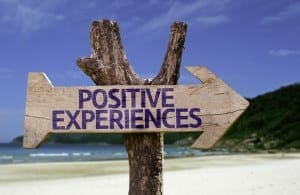Today’s Guest Post is by Duct Tape Marketing Consultant, David Smith – Enjoy!

If you are a small business owner, you instinctively know it’s a wonderful thing when a customer receives value AND has a very positive experience when they deal with your business.
If the journey is hard and the experience is on par with your peers, or worse, unpleasant, you’ll have no chance of building a lasting relationship (loyalty) with the customer. You’ll miss out on the repeat business and referrals that delighted customers bring.
Plainly speaking: The better the experience with your business, the more opportunity you will have with the customer.
That is why Customer Experience (CX) has become a much talked about element for building a successful business.
The major consultancies (Gartner, Forrester, etc.) define Customer Experience in a common way: customer feelings and perceptions caused by interactions with your business. Large companies are advised to have coordinated and consistent experiences across their multiple channels and business units. Many large organizations have an entire department focused on nothing but Customer Experience.
If you are a small business, the complexities of multiple business units may not exist. Your sales transaction, support, service, training, and other opportunities to craft customer experiences go through a small set of people and systems within your business. With limited resources, effectively designing and managing the Customer Experience can become overwhelming to a small business.
By taking a simple approach, a small business can achieve the same results as a large organization that has a Customer Experience Officer or Department.
Using a small business perspective may be the best way for you to think, plan, and implement interactions that achieve positive feelings about your business.
Instead of thinking Customer Experience (macro) think Customer Journey (micro).
Simply put – break it down.
Practically speaking, the Customer Experience is made up of many Customer Journeys. The Customer Journey is the path customers take to solve a particular problem or need. In some cases, the journey results in a transaction for a good or service, which is why the Customer Journey is sometimes also called the Buyer’s Journey.
Customer Journeys are repeated for every instance where the consumer is purposely engaged and looking to achieve a value outcome. The cumulative effect of these interactions creates the Customer Experience.
By breaking it down, moving from the macro view of Experience to the micro view of Journeys, you can begin to simplify and design the interactions of your customers one at a time. The Journeys are simply the interactions and opportunities you have to deliver value and build positive feelings in your customer.
There are potentially dozens of major points of interaction within a small business. Examples include interactions from:
- the initial purchase
- returning customers
- support or service
- training or instruction
- billing or administration
If you use a consistent framework, such as the Duct Tape Marketing Hourglass™, you can define the customer progression toward value and positive feelings. The Hourglass will allow you to map the progress the customer takes from discovering they Know, Like, and Trust your business, into the conversion phase of the Hourglass, Try and Buy.
The Customer Journey doesn’t have to be complicated. Breaking it down into small parts allows you to successfully build systems that deliver value and create positive interaction.
If you liked this post, check out our Small Business Guide to Shaping the Customer Journey.
 David knows first hand the strains of expanding a small business while continually delivering optimal customer and financial results. He comes from a long line of entrepreneurs and understands the ability to gain additional customers and revenue has proven to be the critical element of small business. David helps customers install effective sales and marketing programs via his firm ValensPoint. He earned a degree in Business Administration from Faulkner University (Montgomery, AL). He resides near Anniston, AL.
David knows first hand the strains of expanding a small business while continually delivering optimal customer and financial results. He comes from a long line of entrepreneurs and understands the ability to gain additional customers and revenue has proven to be the critical element of small business. David helps customers install effective sales and marketing programs via his firm ValensPoint. He earned a degree in Business Administration from Faulkner University (Montgomery, AL). He resides near Anniston, AL.

